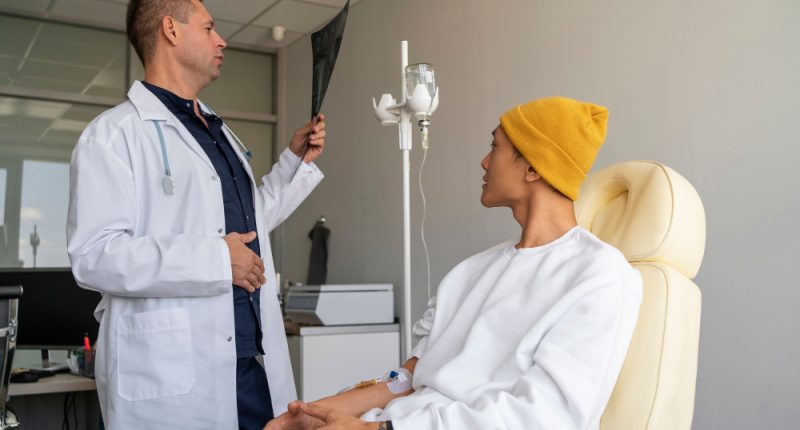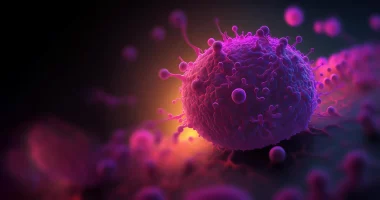In the quest to improve therapeutic outcomes for lymphoma patients, especially those with relapsed or refractory forms of the disease, new treatments like programmed cell death-1 (PD-1) immunotherapy have been a promising avenue. PD-1 immunotherapy has been extensively studied for its efficacy in modulating the immune system to fight cancer. However, monitoring and understanding the metabolic changes in the body during this treatment is crucial to optimizing therapeutic strategies and predicting outcomes. In groundbreaking research conducted by Linlin Guo, Rang Wang, and Guohua Shen, a study aimed to analyze how fluorine-18 fluorodeoxyglucose (FDG) uptake changes in various organs during PD-1 immunotherapy might correlate with treatment efficacy.
This prospective study investigated the metabolic responses in reference organs (liver and mediastinum) and lymphoid cell-rich organs (spleen and bone marrow) through serial monitoring using FDG PET/CT scans in 66 lymphoma patients. The primary focus was to determine whether changes in uptake values, measured as mean and maximum standardized uptake values (SUVs), could be linked to tumor burden and clinical response. Additionally, immune-related adverse events were documented to assess their impact on the metabolic changes observed in these organs.
The findings indicated notable patterns: changes in FDG uptake in lymphoid organs correlated with the clinical response to therapy, providing a potential biomarker for assessing patient response to PD-1 immunotherapy. This research contributes to a deeper understanding of metabolic shifts during immunotherapy, paving the way for enhanced patient-specific treatment protocols in lymphoma therapy.
The use of PD-1 immunotherapy has marked a significant advancement in the treatment of several types of cancer, including lymphoma. PD-1, or programmed death-1, is a receptor on T cells, which are a type of immune cell. When PD-1 binds to its ligands, PD-L1 or PD-L2, the immune response is suppressed. Many cancers exploit this pathway to dampen the immune response against them. PD-1 inhibitors work by blocking this receptor, thereby enhancing the body’s immune response against cancer cells.
Lymphomas are a diverse group of blood cancers that involve cells of the immune system, such as B cells, T cells, and natural killer (NK) cells. The traditional treatment modalities for lymphoma include chemotherapy, radiation therapy, and stem cell transplants. However, relapsed and refractory lymphoma remains a substantial therapeutic challenge. PD-1 immunotherapy has provided new hope in these cases, often showing effectiveness where other treatments have failed.
Despite the promise of PD-1 inhibitors in treating cancers, not all patients respond well, and the variability in treatment response is a critical area of research. Monitoring and predicting responses to PD-1 immunotherapy hence become crucial. Commonly, imaging techniques such as positron emission tomography (PET) combined with computed tomography (CT) scans, using fluorine-18 fluorodeoxyglucose (FDG), are employed to assess the metabolic activity of tumors in response to therapy. FDG is a glucose analog, and areas of high FDG uptake in scans generally correspond to tissues with high glucose metabolism, which typically indicates a higher presence or activity of cancer cells.
Linlin Guo, Rang Wang, and Guohua Shen’s research explored beyond these traditional usages of FDG-PET/CT scans, venturing into how metabolic changes in non-tumorous organs might serve as indicators of response to therapy. Their focus on lymphoid cell-rich organs like the spleen and bone marrow, as well as reference organs such as the liver and mediastinum, provided a broader view of the systemic effects of PD-1 immunotherapy. This approach acknowledges that the immune response influenced by PD-1 blockers involves multiple organs and cellular networks, which in turn affects the overall metabolic landscape of the body.
The study’s findings that correlate changes in FDG uptake with clinical outcomes could revolutionize how clinicians monitor the efficacy of PD-1 inhibitors. Such insights into metabolic shifts could lead to the development of more precise, personalized treatment strategies, potentially identifying earlier in the treatment process which patients are likely to benefit from PD-1 immunotherapy.
Furthermore, documenting immune-related adverse events and linking these to metabolic changes in pivotal organs could improve the management of side effects associated with these therapies. This aspect of the research highlights the balance between enhancing immune response against cancer cells and inadvertently triggering undesirable immune reactions in other parts of the body.
Overall, the study contributes critical data and insights, enhancing our understanding of the complex interactions within the immune system during PD-1 immunotherapy and opening up new avenues for optimizing lymphoma treatment.
In the study by Linlin Guo, Rang Wang, and Guohua Shen, the methodology used to explore the metabolic changes during PD-1 immunotherapy in lymphoma patients was carefully designed to obtain robust and informative data. The key aspects of the study’s methodology included patient selection, treatment protocol, PET/CT imaging procedures, and data analysis techniques.
Patient Selection
The study cohort consisted of 66 lymphoma patients who had either relapsed or were refractory to standard treatments. All participants provided informed consent, and the study was approved by the ethical committee of the institution. Patients were eligible for inclusion if they met specific criteria: a confirmed diagnosis of lymphoma, measurable disease as per the Revised Response Criteria for Malignant Lymphoma, and failure to respond to at least one prior line of therapy. Exclusion criteria included previous exposure to PD-1 inhibitors, concurrent use of other investigational drugs, and any significant health condition that could interfere with the study outcomes.
Treatment Protocol
Participants underwent PD-1 immunotherapy using an FDA-approved PD-1 inhibitor. The treatment involved regular doses administered intravenously according to the product’s labeling. Therapy was continued until disease progression, unacceptable toxicity, or withdrawal of consent. The therapeutic efficacy and safety of the treatment were monitored throughout the study duration, which was predefined based on typical treatment cycles and follow-up periods in clinical practice.
PET/CT Imaging Procedures
FDG PET/CT scans were performed at baseline (before the initiation of PD-1 therapy) and at multiple follow-up points during the treatment. The scanning protocol was standardized to ensure consistency. Patients were instructed to fast for at least 6 hours before imaging to minimize non-cancerous glucose uptake. Prior to scanning, blood glucose levels were measured to ensure suitability for FDG injection. A standard dose of FDG was administered intravenously, and scans were acquired approximately 60 minutes post-injection.
Images were acquired from the skull base to the mid-thigh using a PET/CT scanner. Both the PET and CT images were interpreted by experienced radiologists and nuclear medicine physicians blinded to the clinical data. Standardized uptake values (SUVs), including mean SUV (SUVmean) and maximum SUV (SUVmax), were calculated for designated organs: the liver, mediastinum, spleen, and bone marrow.
Data Analysis
The primary endpoint of the study was to determine the correlation between changes in FDG uptake in the observed organs and clinical outcomes, including overall response rate (ORR) and progression-free survival (PFS). Quantitative changes in SUVs were analyzed using statistical software. Comparisons were made between baseline and follow-up scans to assess metabolic changes.
Secondary analyses involved evaluating the relationship between these metabolic changes and immune-related adverse events (irAEs). These events were documented and graded according to common criteria, and their impact on metabolic responses was assessed statistically.
The sophisticated methodology used in this study allowed the researchers to systematically evaluate the potential of FDG PET/CT scans not only to monitor tumor response but also to understand the broader systemic effects of PD-1 immunotherapy in lymphoma patients. This approach provided invaluable insights into the immunometabolic interplay during such therapies, contributing to more personalized and effective management strategies for patients with relapsed or refractory lymphoma.
Key Findings and Results
The study by Linlin Guo, Rang Wang, and Guohua Shen yielded pivotal insights into the metabolic responses of lymphoma patients undergoing PD-1 immunotherapy. The results highlighted significant correlations between the metabolic changes in specific organs and the clinical outcomes of the treatment, suggesting novel biomarkers for monitoring and predicting the efficacy of immunotherapy.
FDG Uptake Changes and Clinical Response
One of the most significant findings of the study was the distinct patterns of FDG uptake in lymphoid organs (spleen and bone marrow) and reference organs (liver and mediastinum). Following the administration of PD-1 inhibitors, the researchers observed reductions in SUVmax and SUVmean values in the spleen and bone marrow of patients who responded to the therapy. This reduction correlated with clinical improvements, including remission rates and progression-free survival.
Conversely, in patients who did not show a clinical response, FDG uptake either remained stable or slightly increased, indicating ongoing metabolic activity associated with disease persistence or progression. This clear differentiation in metabolic behavior between responders and non-responders provided a quantifiable method of assessing treatment effectiveness early in the therapy course.
Immune-Related Adverse Events and Metabolic Changes
Another crucial aspect of the study was documenting and analyzing immune-related adverse events (irAEs). Approximately 24% of patients experienced mild to moderate irAEs, primarily involving the skin, gastrointestinal tract, and endocrine system. Interestingly, there was a notable correlation between the occurrence of irAEs and alterations in FDG uptake in the mediastinum and liver, areas not primarily involved in lymphoma but indicative of systemic immune activation.
Patients experiencing irAEs often showed a transient increase in FDG uptake, followed by a normalization or reduction coinciding with the management of these events and continuation of therapy. This pattern suggests that irAEs, while potentially detrimental, could also signal a heightened immune state possibly favorable for antitumoral activity.
Predictive Value of Early Changes in FDG Uptake
One of the groundbreaking aspects of the findings was the predictive value of early changes in FDG uptake. Patients who demonstrated a decrease in SUV values during the initial follow-up scans generally had better long-term outcomes compared to those with stable or increased uptake. This early indication could potentially help clinicians decide on continuing, adjusting, or discontinuing PD-1 inhibitor therapy, tailoring treatment to achieve the best response while minimizing unnecessary exposure to drugs that may not be beneficial.
Broader Implications for Lymphoma Treatment
The study’s results have broader implications for the treatment of lymphoma. By linking metabolic changes in non-tumorous organs to the efficacy of immunotherapy, the research opens up new avenues for monitoring therapies beyond traditional tumor response criteria. This approach not only enhances understanding of the systemic effects of immunotherapy but also aids in refining treatment protocols and improving patient outcomes through personalized medicine strategies.
Furthermore, the insights gained from the metabolic response patterns could guide the development of combinatory treatment regimes, where PD-1 inhibitors might be paired more effectively with other therapeutic modalities to enhance overall efficacy and manage adverse effects.
Overall, the study by Linlin Guo, Rang Wang, and Guohua Shen marks a significant advancement in the application of FDG PET/CT imaging in oncology, particularly in the context of PD-1 immunotherapy for lymphoma. It provides vital data that could dramatically refine therapeutic strategies and improve the precision and outcome of cancer treatments, offering renewed hope to patients with relapsed or refractory lymphoma.
The implications of the research conducted by Linlin Guo, Rang Wang, and Guohua Shen are profound and broad-ranging, fundamentally enhancing the paradigm of how PD-1 immunotherapy is monitored and optimized in the clinical setting for lymphoma patients. This study elucidates a novel and practical approach to assessing the efficacy and systemic effects of immune modulation therapies through metabolic imaging, which can significantly influence future research and clinical practices.
Enhancing Personalized Medicine Approaches
The ability to monitor metabolic changes in lymphoid and reference organs using FDG PET/CT scans and correlate these changes with treatment response provides a potent tool for personalized medicine. Clinicians can potentially predict which patients are likely to benefit from PD-1 inhibitors early in the treatment process, reducing unnecessary exposure to potentially ineffective therapies and allowing for more precise tailoring of therapeutic regimens. This not only optimizes patient outcomes but also reduces the financial and psychological burdens associated with ineffective treatment trials.
Advancing Treatment Monitoring Methods
Traditionally, the efficacy of cancer therapies has been evaluated through direct tumor response measurements, often overlooking the systemic interactions that play a crucial role in patient outcomes. By incorporating the assessment of metabolic changes in both tumorous and non-tumorous organs, this research paves the way for a more comprehensive monitoring system that considers both the direct and indirect effects of cancer therapies. This holistic view could lead to more robust and predictive models of treatment efficacy, particularly in complex diseases like lymphoma where the immune environment significantly impacts disease progression and treatment response.
Guiding Combinatorial Therapy Development
The insights from this study into how metabolic responses correlate with clinical outcomes and immune-related adverse events open avenues for integrating PD-1 inhibitors with other therapies. Understanding the metabolic and immune landscape during PD-1 therapy could help in designing combination treatments that potentially enhance efficacy and manage or mitigate adverse effects. For instance, pairing PD-1 inhibitors with targeted therapies that modulate different arms of the immune system based on the individual’s metabolic response could yield more effective therapeutic outcomes.
Accelerating Research on Immune-Metabolomic Interactions
This research underscores the importance of the interplay between metabolism and the immune system in cancer therapy, an area ripe for exploration. It could stimulate additional studies aimed at understanding the underlying mechanisms driving the observed metabolic changes during PD-1 immunotherapy and their implications for cancer progression and therapy resistance. Such knowledge is vital for developing next-generation immunotherapies that are more efficient and less susceptible to resistance.
Implications for Clinical Guidelines and Policies
The methodologies and findings of this study could influence future clinical guidelines and health policies by advocating for the inclusion of metabolic imaging as a routine part of immunotherapy protocols. It makes a compelling case for regulatory bodies and healthcare providers to recognize the value of comprehensive metabolic and immune response monitoring, potentially leading to revised standards that promote better clinical practices and enhanced patient care.
In summary, the study by Linlin Guo, Rang Wang, and Guohua Shen not only contributes valuable insights into the metabolic dynamics of PD-1 immunotherapy but also catalyzes a shift towards more informed, precise, and patient-centric approaches in the management of lymphoma and potentially other cancers. It represents a significant leap forward in the convergence of imaging, immunology, and oncology, heralding a new era of cancer therapy where treatment decisions are increasingly driven by integrated biological markers.
Future Directions and Final Thoughts
The groundbreaking study by Linlin Guo, Rang Wang, and Guohua Shen has significantly advanced our understanding of PD-1 immunotherapy in lymphoma, setting a solid foundation for future research and clinical practice. As we look forward, several key areas emerge where further exploration could amplify the benefits of this research and lead to further enhancements in the treatment of lymphoma and other cancers.
Deepening Understanding of Metabolic and Immunologic Interactions
While this study provides important initial insights into how metabolic changes correlate with immune responses during PD-1 immunotherapy, there is much that remains unknown about the underlying biological mechanisms. Future research should delve deeper into the molecular and cellular interactions that drive these changes. Understanding the biochemistry behind these shifts could unveil new therapeutic targets and strategies to enhance or modulate the immune response more effectively.
Expanding to Other Forms of Cancer
Given the success of this methodology in lymphoma, an expansion of this research to include other cancer types would be a natural progression. Similarly, immunotherapies have shown promise across a range of cancers, and studying metabolic responses in these different contexts could help refine treatment strategies universally. Comparative studies across cancers could elucidate whether these metabolic biomarkers are universally applicable or specific to certain cancers.
Enhancing Imaging and Analysis Technologies
Technological advancements in imaging and data analysis could further refine the precision with which metabolic changes are monitored. The development of more sensitive and specific imaging agents that target particular immune cells or cancer markers could provide even clearer insights into treatment responses and might enable the detection of subtler changes that current FDG PET/CT scans may miss.
Integration into Clinical Protocols
Implementing findings from this study into routine clinical practice will involve collaboration between researchers, clinicians, and policymakers. Creating guidelines for the use of metabolic imaging as a standard part of monitoring PD-1 immunotherapy requires not only scientific validation but also consideration of cost-effectiveness, accessibility, and education for healthcare providers on interpreting these new types of data.
Personalized and Combinatory Therapeutic Approaches
Armed with deeper insights into the metabolic and immune responses of individual patients, clinicians can better tailor combination therapies. For example, integrating PD-1 inhibitors with therapies targeting specific metabolic pathways that are active in particular patients could enhance therapeutic efficacy and reduce side effects. This approach would represent a move towards truly personalized medicine.
Concluding Reflections
The research conducted by Linlin Guo, Rang Wang, and Guohua Shen marks a transformative step in the evolution of cancer treatment, illuminating the potential of metabolic imaging to enhance the efficacy and precision of immunotherapy in lymphoma. As this field advances, the integration of metabolic and immune monitoring could become a cornerstone of cancer therapy, leading not just to more effective treatments but also to more hopeful outcomes for patients facing this challenging disease.
Ultimately, this study not only enhances our scientific understanding but also opens up new, patient-centered approaches to cancer treatment, emphasizing the importance of individual responses and the potential for tailored therapeutic strategies. Moving forward, the continued exploration of these concepts will undoubtedly raise new questions, challenge existing paradigms, and inspire innovative solutions that further improve the lives of patients battling cancer. The future of oncology looks promising, with metabolic imaging poised to play a pivotal role in shaping next-generation cancer therapies.








